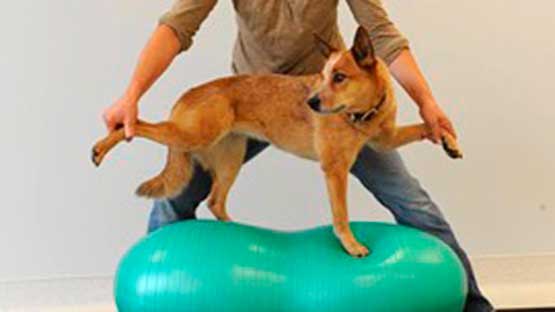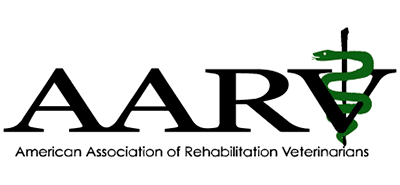What Is Rehabilitation?
Rehabilitation is the diagnosis and management of patients with painful or functionally limiting conditions, particularly those with injury or illness related to the neurologic and musculoskeletal systems. The goal of rehabilitation is to achieve the highest level of function, independence and quality of life possible for the patient.
Veterinarians certified in animal rehabilitation provide leadership to a rehabilitative team that can consist of other veterinary professionals, such as physical therapists, technicians and rehabilitation therapists. They will work closely with your pet's primary care and specialty veterinarians. Your rehab-certified veterinarian can prescribe pain medications if needed and may offer therapies such as acupuncture and spinal manipulative therapy. They will also prescribe a treatment program including additional therapies (see Rehab Therapies) that is specifically designed to meet your pet's needs. This multimodal approach provides greater opportunity for a successful outcome.
Definition of a school:
- An institution designed to provide an educational environment for teaching attendees under direct or indirect faculty supervision.
- An educational institution where higher education is taught.
- Any entity (individual, business, or institution) that charges tuition for postsecondary training or education.
- Schools can be divided into (not a complete list):
- Vocational schools = can be either secondary or postsecondary Education providing vocational or technical skills required to complete the tasks of a particular job.
- Avocational schools = a postsecondary institution that offers courses/programs designed exclusively for professional development
- Degree-granting institutions = depend on their state regulations and higher education accreditation. These will be under the accrediting agencies recognized by the US Department of Education https://ope.ed.gov/dapip/#/agency-list or other organizations like the Council for Higher Education Accreditation (https://www.chea.org/understanding-chea-recognition). Those accredited under the US Dept. of Education can be identified by ".edu" as part of their URL address.
Credentials for schools providing any programs, be it postgraduate or continuing education (CE):
- Approval or recognition by national associations can be sought.
- Associations cannot accredit but can approve specific programs. For example, from the continuing education point of view, the American Association of Veterinary State Boards – RACE does not accredit but approves Continuing Education contact hours. The American Veterinary Medical Association recognizes those Vet Med/Vet Tech programs that the Council on Education has accredited. As stated by the AVMA Council on Education: The AVMA Council on Education® (AVMA COE®) accredits DVM or equivalent educational programs. The AVMA COE assures that minimum standards in veterinary medical Education are met by all AVMA-accredited colleges of veterinary medicine, and that students enrolled in those colleges receive an education which will prepare them for entry-level positions in the profession.
- Most schools/institutions accepting tuition must also be approved in their state by their respective educational boards. The jurisdiction may fall under their state department of Education. Depending on the state, a specific board or Board of reagents will oversee the approval of the schools and programs. The state-approval process may take up to one and a half years.
- Schools/Institutions, although they are not required to, can voluntarily apply to be accredited by:
- Any of the US Dept. of Education recognized accrediting agencies (https://ope.ed.gov/dapip/#/agency-list).
- Examples of other nationally recognized agencies include:
- CHEA: Council for Higher Education Accreditation (www.chea.org).
- National Commission for Certifying Agencies (NCCA): https://www.credentialingexcellence.org/Accreditation/Earn-Accreditation/NCCAÂ
Why should schools/institutions have credentials?
- Protect those that register to attend any of the offered programs.
- Ensures that the school/institution has undergone a thorough evaluation by an independent agency.
- Ensure that the institution provides what they say they will provide.
- They provide credibility to the profession that they are representing.
- Attendees can use those credentials when advertising (after successfully completing the program).
Terminology clarification:
- Continuing Education is provided through contact hours, not credits. The use of "credits" is reserved for colleges or universities. For example, a one-credit program provides a MINIMUM of thirty (30) and up to thirty-three (33) contact hours of training, either supervised or not.
- Certificate of Attendance = a certificate providing documentation that you attended an educational event, either partially or entirely. According to the National Commission of Certifying Agencies (NCCA), and the Institute for Credentialing Excellence (ICE), "possession of a certificate of attendance or participation does not indicate that the participant has accomplished the intended learning outcomes."
- Certification = Sometimes, "credential" can also be synonymous with "certification." The certification focuses on individuals evaluated based on knowledge and clinical competency standards. Those who complete certification must maintain competency and stay current with advancements in the specific field by attending to and maintaining CE requirements. It is essential to understand that the certification program provider is NOT the sole source of other educational training, to allow the holder to benefit from additional training and method of delivery.
- Board Certification = Is awarded to an individual who has applied, approved, and taken an extensive evaluation of knowledge and competency by a recognized Veterinary Specialty Board. The AVMA recognized Veterinary Specialty Organization or ABVS (https://www.avma.org/education/veterinary-specialties), and their respective colleges award the Diplomate status and description of "Board-Certified Veterinary Specialist" to those that complete all requirements and examinations. The same holds for the only other licensed veterinary professionals. The National Association of Veterinary Technicians in America, and their Committee on Veterinary Technician Specialties, grant VTS to licensed Veterinary Technicians (https://navta.site-ym.com/page/specialties).
Common mistakes and misunderstandings.
- A certificate of attendance or certification (see above description) is not the same as being Board Certified, Boarded, or Specialist.
- All those registering for any program should do their research to ensure they are attending the program with desired credentials.
Acronyms utilized in the field of veterinary rehabilitation:
- ASTR = Animal Sports Therapy and Rehabilitation provided by the Academy of Animal Sport Science (www.academyofanimalsportscience.com).
- CCAT = Certified Companion Animal Therapist, provided by Northeast Seminars and North Carolina State University College of Veterinary Medicine (www.ncsuvetce.com).
- CCRP, or CERP = Certified Canine Rehabilitation Practitioner and Certified Equine Rehabilitation Practitioner, respectively. Provided by the Veterinary Academy of Higher Learning and the University of Tennessee (www.utvetrehab.com/).
- CCRT or CCRVN = Certified Canine Rehabilitation Therapist and Certified Canine Rehabilitation Veterinary Nurse, respectively. Provided by the Canine Rehabilitation Institute (www.caninerehabinstitute.com).
- CERPV = Certified Rehabilitation & Performance Medicine Veterinarian, provided by the Integrative Veterinary Medical Institute (https://www.ivmi.us).
- CVMRT = Certified in Veterinary Massage and Rehabilitation Therapy, provided by the Healing Oasis Wellness Center (www.healingoasis.edu).
- IRPM = Integrative Rehabilitation & Physical Medicine provided by CuraCore (https://curacore.org/vet/).
- VTS (Physical Rehab) = Licensed veterinary technician with the specialty area of Physical Rehabilitation.
- DACVSMR = Diplomate of the American College of Veterinary Sports Medicine and Rehabilitation; a licensed veterinarian that is Board Certified and considered a specialist in the field of sports medicine and rehabilitation.
***Highlighted in green = those that attend are NOT considered specialists.
***Highlighted in yellow = ARE considered specialists
As stated on the American Association of Rehabilitation Veterinarians (AARV) website:
Veterinary rehabilitation is a rapidly growing field, and educational opportunities for practitioners engaging in rehabilitation are expanding. Practitioners and therapists trained and certified in animal rehabilitation come from various disciplines. Depending on a specific program's requirements, varied licensed health care professionals may participate and certify in aspects of veterinary rehabilitation. The AARV does not endorse any program and calls on the prospective student to make an informed decision. The following list, though not exhaustive, provides some questions that the students should ask to compare among programs:
- Does the program provide AAVSB-RACE-approved continuing Education that the student can use when renewing their license?
- Does the faculty include Diplomates from the American College of Veterinary Sports Medicine and Rehabilitation?
- What is the student-to-faculty ratio during supervised hands-on practicums?
- Do they provide enough supervised hands-on practicum or are externships required?
- What specific training programs in veterinary rehabilitation does the program offer?
- Does the institution present other credentials that may benefit the student?
NOTE: Each prospective student must make an informed decision on which program to attend. Clients should have the opportunity to be educated about the training that their practitioners have received.

